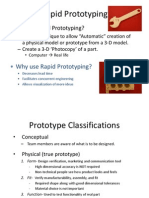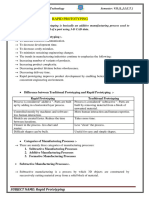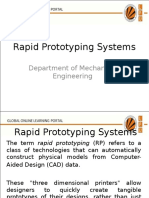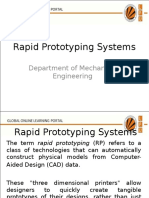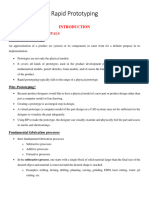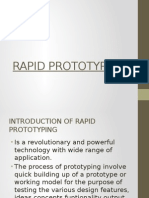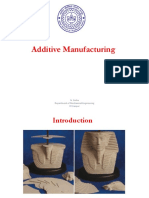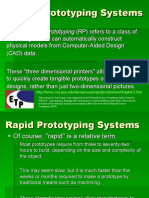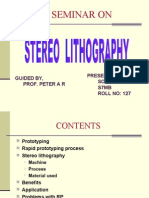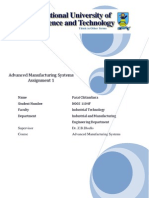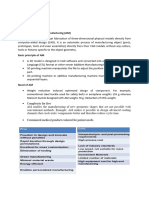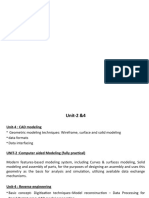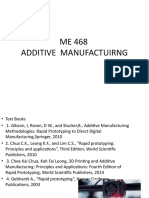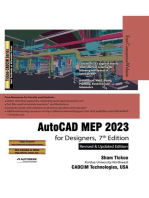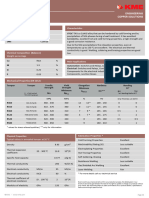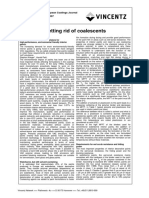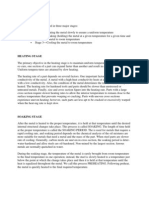RAPID PROTOTYPING 1st Module 1
RAPID PROTOTYPING 1st Module 1
Uploaded by
Mohamed Hamdan ACopyright:
Available Formats
RAPID PROTOTYPING 1st Module 1
RAPID PROTOTYPING 1st Module 1
Uploaded by
Mohamed Hamdan AOriginal Title
Copyright
Available Formats
Share this document
Did you find this document useful?
Is this content inappropriate?
Copyright:
Available Formats
RAPID PROTOTYPING 1st Module 1
RAPID PROTOTYPING 1st Module 1
Uploaded by
Mohamed Hamdan ACopyright:
Available Formats
MODULE 1
Introduction
One of the important steps prior to the production of a functional product is building of a physical
prototype. Prototype is a working model created in order to test various aspects of a design,
illustrate ideas or features and gather early user feed-back. Traditional prototyping is typically done
in a machine shop where most of parts are machined on lathes and milling machines.
This is a subtractive process, beginning with a solid piece of stock and the machinist carefully
removes the material until the desired geometry is achieved. For complex part geometries, this is an
exhaustive, time consuming, and expensive process.
A host of new shaping techniques, usually put under the title Rapid Prototyping, are being developed
as an alternative to subtractive processes. These methods are unique in that they add and bond
materials in layers to form objects. These systems are also known by the names additive fabrication,
three dimensional printing, solid freeform fabrication (SFF), layered manufacturing etc.
These additive technologies offer significant advantages in many applications compared to classical
subtractive fabrication methods like formation of an object with any geometric complexity or
intricacy without the need for elaborate machine setup or final assembly in very short time.
This has resulted in their wide use by engineers as a way to reduce time to market in manufacturing,
to better understand and communicate product designs, and to make rapid tooling to manufacture
those products. Surgeons, architects, artists and individuals from many other disciplines also
routinely use this technology.
Prototype: It is a model fabricated to prove out a concept or an idea.
Solid Modelling: It's a branch of CAD that produces 2D or 3D objects in an electronic format.
Definitions: Rapid prototyping is basically an additive manufacturing process used to quickly
fabricate a model of a part using 3-D CAM data.
It can also be defined as layer by layer fabrication of 3D physical models directly from CAD.
Need for the compression in product development
• To increase effective communication.
• To decrease development time.
• To decrease costly mistakes.
• To minimize sustaining engineering changes.
• To extend product life time by adding necessary features & eliminating redundant features early in
the design.
Trends in manufacturing industries emphasis the followings:
• Increasing the no of variants of products.
• Increase in product complexity.
• Decrease ir product lifetime before obsolescence.
FIND MORE NOTES @ VTUMECHNOTES.COM NOTES MADE BY ANISH JAIN
• Decrease in delivery time.
• Product development by Rapid prototyping by enabling better communication.
Conventional Machining:
• Its not suitable for complex shapes because they are difficult to machine.
• Time consuming
• Very costly
• Tedious or very laborious.
• Skilled operator is required.
• Accuracy will be less.
• Increased product development time.
Pre-processing:- CAD model slicing & setting algorithms applied for various RP systems.
Post-processing:- Cleaning operations required to finish a part after removing it from RP machine.
Materials for Rapid Prototyping- Paper, Wax, Plastics, Resins, Metallic powders.
Methodology of Rapid Prototyping:
RP in its basic form can be described as the production of three dimensional (3D) parts from
computer aided design (CAD) data in a decreased time scale. The basic methodology of all RP
process can be summarized as shown in following figure.
FIND MORE NOTES @ VTUMECHNOTES.COM NOTES MADE BY ANISH JAIN
• Construct a CAD model.
• Convert it to STL format.
• RP machine processes .STL file by creating sliced layers of model.
• First layer of model is created.
• Model is then lowered by thickness of next layer.
• Process is repeated until completion of model
• The model & any supports are removed.
• Surface of the model is then finished and cleaned.
(1) Development of a CAD model
The process begins with the generation CAD model of the desired object which can be done by one
of the following ways;
• Conversion of an existing two dimensional (2D) drawing
• Importing scanned point data into a CAD package
• Creating a new part in CAD in various solid modeling packages
• Altering an existing CAD model
RP has traditionally been associated with solid rather than surface modelling but the more recent
trends for organic shapes in product design is increasing the need for free flowing surfaces
generated better in surface modelling.
(2) Generation of Standard triangulation language (STL) file
The developed 3D CAD model is tessellated and converted into STL files that are required for RP
processes. Tessellation is piecewise approximation of surfaces of 3D CAD model using series of
triangles. Size of triangles depends on the chordal errorior maximum fact deviation.
For better approximation of surface and smaller chordal error, small size triangle are used which
increase the STL file size. This tessellated CAD data generally carry defects like gaps, overlaps,
degenerate facets etc which may necessitate the repair software. These defects are shown in figure
below. The STL file connects the surface of the model in an array of triangles and consists of the X, Y
and Z coordinates of the three vertices of each surface triangle, as well as an index that describes the
orientation of the surface normal.
(3) Slicing the STL File
Slicing is defined as the creating contours of sections of the geometry at various heights in the
multiples of layer thickness. Once the STL file has been generated from the original CAD data the
next step is to slice the object to create a slice file (SLI). This necessitates the decision regarding part
deposition orientation and then the tessellated model is sliced. Part orientation will be showing
considerable effect on the surface as shown in the figures.
FIND MORE NOTES @ VTUMECHNOTES.COM NOTES MADE BY ANISH JAIN
The thickness of slices is governed by layer thickness that the machine will be building in, the thicker
the layer the larger the steps on the surface of the model when it has been built. After the STL file
has been sliced to create the SLI files they are merged into a final build file. This information is saved
in standard formats like SLC or CLI (Common Layer Interface) etc.
FIND MORE NOTES @ VTUMECHNOTES.COM NOTES MADE BY ANISH JAIN
(4) Support Structures
As the parts are going to be built in layers, and there may be areas that could float away or of
overhang which could distort. Therefore, some processes require a base and support structures to
be added to the file which are built as part of the model and later removed.
(5) Manufacturing
As discussed previously, the RP process is additive i.e. it builds the parts up in layers of material from
the bottom. Each layer is automatically bonded to the layer below and the process is repeated until
the part is built. This process of bonding is undertaken in different ways for the various materials
that are being used but includes the use of Ultraviolet (UV) lasers, Carbon Dioxide (COz) lasers, heat
sensitive glues and melting the material itself etc
(6) Post Processing
The parts are removed from the machine and post processing operations are performed sometimes
to add extra strength to the part by filling process voids or finish the curing of a part or to hand finish
the parts to the desired level. The level of post processing will depend greatly on the final
requirements of the parts produced, for example, metal tooling for injection molding will require
extensive finishing to eject the parts but a prototype part manufactured to see if it will physically fit
in a space will require little or no post processing.
History of RP systems
• It started in 1980's
• First technique is Stereo lithography (SLA)
• It was developed by 3D systems of Valencia in California, USA in 1986.
• Fused deposition modeling (FDM) developed by stratasys company in 1988.
• Laminated object manufacturing (LOM) developed by Helisis (USA).
• Solid ground Curing developed by Cubitol corporation of Israel.
• Selective laser sintering developed by DTM of Austin, Texas (USA) in 1989.
• Sanders Model maker developed by Wilton incorporation USA in 1990.
• Multi Jet Modeling by 3D systems.
• 3-D Printing by Solygen incorporation, MIT, USA.
FIND MORE NOTES @ VTUMECHNOTES.COM NOTES MADE BY ANISH JAIN
Classification of RP systems.
Rapid Prototyping technologies are classified based on the initial form of its material i.e., the base
material of prototype or part to be built. Thus, rapid prototyping technologies are classified into 3
categories
Solid Based Rapid Prototyping System Solid based rapid prototyping systems are meant to
encompass all the forms of materials in solid state. The solid form can include the shape in the form
of a wire, laminate, pellets or a roll. Solid-based rapid prototyping systems works on the following
principles:
(i.) Cutting and Glueing / Joining method.
(ii). Melting and Solidifying / Fusing method.
These processes are different from one another, though some of them use the laser in the process
of fabricating prototypes. They all utilize solid in one form or the other, as the primary medium to
create a prototype.
Liquid Based Rapid Prototyping System
Liquid based rapid prototyping systems have the initial form of its material in liquid state. The base
material can include a resin or a polymer. Liquid based rapid prototyping systems works on the
principle of ‘Photo curing’ under which three methods are possible
i. Single laser beam method
ii. Masked lamp method
iii. Two laser beam method
FIND MORE NOTES @ VTUMECHNOTES.COM NOTES MADE BY ANISH JAIN
Most of these systems build parts in a vat of photo-curable resin, an organic resin that solidifies
under the exposure to laser radiation, in UV range. The laser cures the resin near the surface,
forming a hardened layer.
The formed layer is lowered by an elevation control system to allow the next layer of resin to be
similarly formed over it. This continues until the entire part is completed. Under liquid based rapid
Prototyping system, stereo lithography is very unique and patented process which combines CAD,
CAM, CAE, Laser Scanning, Optical Scanning technologies including chemistry to fabricate 3D solid
models from 3D CAD data
Powder Based Rapid Prototyping System
Powder particles are by-and-large to the particles of solid state in a strict context. However,
intentionally it is categorized outside the solid-based rapid prototyping systems to refer powder in
grain form. All the powder based rapid prototyping systems works on the principle of
Joining/Binding.
The method of joining / binding differs for all the systems, in that some employ a laser while others
use a binder/glue to achieve the joining effect. Binder material is deposited on to selected regions of
layer of powder particles to produce a layer of powder particles that are completely bonded at the
selected regions.
Iterations would fabricate the desired part. Post-processing is highly required to remove the
unbonded powder particles
Application of Rapid Prototyping –
Medical Applications: Rapid Prototyping is used to build solid replicas of all human organs and
parts. Components like stretchers, broken limbs, prosthetics, etc., are majorly fabricated for bio-
medical applications. The process involves the conversion of medical images to .STL files. The
accuracy of reproduction of plastic models was notably superior.
Design Applications: Parts fabricated by Rapid Prototyping method helps in design visualization,
concept understanding and visual verification of the end part or the product.
Engineering Applications: The Rapid prototyping systems helps in fabricating parts to required
scales, to determine form and fit sizes, prototypes to perform flow analysis in various fields such as
aerospace, automotive, bio-medical , ship-building industries. Due to various potential benefits in
the rapid prototyping and 3D printing processes in membrane manufacturing, the use of the process
of rapid prototyping in membrane engineering systems shows significant application.
Aerospace And Automotive Applications: The rapid prototyping process has wide applications in
aerospace and automotive fields; for design, visual verification, assembly, form, fit, limits,
tolerances, clearances, inspection, testing, prosthetics, 3D casts, Metal casting etc.,
Manufacturing Applications: Tools and parts such as moulds, castings-metal or sand, master
pattern making using materials such as resins, rubbers, metals and ceramics etc., can be fabricated
for their respective applications. Wind tunnel model components can be fabricated for its
applications i.e., lightly loaded wind tunnel model components, also investment casting using rapid
prototyping for pattern development offers strength and high production.
FIND MORE NOTES @ VTUMECHNOTES.COM NOTES MADE BY ANISH JAIN
In addition to the above applications, rapid prototyping process shows its technological growth in
textile industry, furniture design, electrical appliances, and architectural interior design and design of
special and complicated contour objects.
Thus, the technology has been developing rapidly from past few decades, indicating a greater
potential for further development and its applications in various disciplines. Also, the part fabricated
from a technological concept, would develop valuable manufacturing trifecta along the traditional
equivalent and subtractive manufacturing processes
Stereo Lithography Systems:
Introduction
it is the first RP system developed by 3D SYSTEMS of Valencia in California, USA in 1996.
First Model developed was 250/50 followed by 250/30, 3500, 5000 and 7000.
Principle
SLA is a laser based Rapid Prototyping process which builds parts directly from CAD by curing or
hardening a photosensitive resin with a relatively low power laser
StereoLithography (SL) is the best known rapid prototyping system. The technique builds three-
dimensional models from liquid photosensitive polymers that solidify when exposed to laser beam.
The model is built upon a platform in a vat of photo sensitive liquid.
A focused UV laser traces out the first layer, solidifying the model cross section while leaving excess
areas liquid. In the next step, an elevator lowers the platform into the liquid polymer by an amount
equal to layer thickness. A sweeper recoats the solidified layer with liquid, and the laser traces the
second layer on the first. This process is repeated until the prototype is complete.
Afterwards, the solid part is removed from the vat and rinsed clean of excess liquid. Supports are
broken off and the model is then placed in an ultraviolet oven for complete curing.
Parameters:
Laser Type: Helium Cadmium Laser (He-Cd)
Laser Power: 24mW
Laser Life: 2000 hours
Re-coat material: Zaphir
Minimum Slice Thickness: 0.1mm
Beam Diameter: 0.2mm
Scan Speed: 0.75m/sec
Maximum Part Volume: 0.25x0.25x0.25 m
Maximum Part Weight: 9Kgs
FIND MORE NOTES @ VTUMECHNOTES.COM NOTES MADE BY ANISH JAIN
Application Range
• Processing large variety of photo-sensitive polymers including clear, water resistant and flexible
resins
• Functional parts for tests
• Tools for pre series production tests.
• Manufacturing of medical models
• Manufacturing of electro-forms for Electro Discharge Machining
(EDM)
• Form-fit functions for assembly tests.
Advantages
• Possibility of manufacturing parts which are in possible to produce conventionally using a single
process.
• Continuous unattended operation for 24 hours.
• High resolution.
• Any geometrical shape can be made with virtually no limitation.
Disadvantages
• Necessity to have support structures
• Accuracy not in the range of mechanical part manufacturing.
• Restricted areas of application due to given material properties.
• Labour requirements for post processing, especially cleaning.
Software:
(i) SLA CONTROL AND SET UP SOFTWARE: It operates on SLA 250 and SLA 500 machines. It has got
three packages.
a) SLA VIEW: UNIX based system for viewing and positioning.
b) BRIDGE WORKS: UNIX based software for generating support structures.
c) SLA SLICE: Slicing and system operation software.
ii.MAESTRO: UNIX based software
iii.MS WINDOWS NT SOFTWARE (3D LIGHT YEAR), It is used for viewing, positioning, support
generation and slicing, build station for operating SLA machine.
Build Materials Used:
Epoxy Resin, Acrylate Resin
FIND MORE NOTES @ VTUMECHNOTES.COM NOTES MADE BY ANISH JAIN
Epoxy Resin has better material properties and less hazardous but require large exposure time for
curing.
SLA HARDWARE.
The build chamber of SLA contains
1) A removable VAT that holds the build resin.
2) A detachable perforated build platen on a Z axis elevator frame
3) An automated resin level checking apparatus
4) VAT has a small amount of Z movement capability which allows computer to maintain a exact
height per layer.
5) A recoated blade rides along the track at the ton of the rack and serves to smooth the liquid
across the part surface to prevent any rounding off edges due to cohesion effects.
6) Some systems have Zaphyr recoater blade which actually softens up resin and delivers it evenly
across the part surface.
7) Behind the build chamber resides the laser and optics required to cure resin.
8) Laser unit is long rectangular about 4 feet long and remains stationary.
Post Processing:
1) Ultraviolet Oven (Post Curing Apparatus) 2) An alcohol Bath
Clean the part in the alcohol bath and then go for final curing
FIND MORE NOTES @ VTUMECHNOTES.COM NOTES MADE BY ANISH JAIN
FIND MORE NOTES @ VTUMECHNOTES.COM NOTES MADE BY ANISH JAIN
Protect pdf from copying with Online-PDF-No-Copy.com
You might also like
- Stu RPT NotesDocument34 pagesStu RPT NotesVishal DeshpandeNo ratings yet
- Prototyping, Are Being Developed As An Alternative To Subtractive Processes. TheseDocument19 pagesPrototyping, Are Being Developed As An Alternative To Subtractive Processes. TheseBalasivarama ReddyNo ratings yet
- Rapidprototyping 170316110503 PDFDocument66 pagesRapidprototyping 170316110503 PDFDeepthi GangadharNo ratings yet
- Rapid Prototyping: V KalyanamanoharDocument63 pagesRapid Prototyping: V Kalyanamanoharvijaypalika076No ratings yet
- 1 Overview of Rapid Prototyping: o o o o o oDocument15 pages1 Overview of Rapid Prototyping: o o o o o oVaisakh SomakumarNo ratings yet
- Additive MFGDocument18 pagesAdditive MFGEmerald InnovatesNo ratings yet
- Rapid Pro To Typing PrimerDocument13 pagesRapid Pro To Typing Primersinghsujit1No ratings yet
- Unit - 1Document40 pagesUnit - 1rajeshNo ratings yet
- 3D Printing BasicsDocument40 pages3D Printing BasicsBalaji VasudevanNo ratings yet
- Sathyabama University: Sprx1032 - Rapid Prototyping Course MaterialDocument22 pagesSathyabama University: Sprx1032 - Rapid Prototyping Course MaterialRaghuNo ratings yet
- Rapid Pro To Typing SystemsDocument8 pagesRapid Pro To Typing SystemsHarish_12No ratings yet
- Rapid Prototyping Full Seminar Report 989Document17 pagesRapid Prototyping Full Seminar Report 989Girish JawalageriNo ratings yet
- RP - CH 3Document30 pagesRP - CH 3Jemin JhatuNo ratings yet
- Rapid PrototypingDocument22 pagesRapid PrototypingKanishk Gupta100% (2)
- Module 3 Lesson 4Document6 pagesModule 3 Lesson 4subha_aeroNo ratings yet
- Rapid PrototypingDocument24 pagesRapid PrototypingAyush ChopraNo ratings yet
- Rapid PrototypingDocument24 pagesRapid PrototypingAyush ChopraNo ratings yet
- Tutorial: Rapid Prototyping TechnologiesDocument10 pagesTutorial: Rapid Prototyping TechnologiesFilip SvnikolicNo ratings yet
- RP MethodsDocument28 pagesRP Methodssanukumar2382No ratings yet
- Rapid Prototyping Applications by Three Dimensional Printing.Document5 pagesRapid Prototyping Applications by Three Dimensional Printing.Pramod WadateNo ratings yet
- Rapid PrototypingDocument18 pagesRapid PrototypingbngscribdNo ratings yet
- Additive Manufacturing Unit 1Document33 pagesAdditive Manufacturing Unit 1Adarsh NaikNo ratings yet
- L9-TA202A-Additive Manufacturing IDocument57 pagesL9-TA202A-Additive Manufacturing IjthyfgdNo ratings yet
- 07 Final Rapid Prototype ReportDocument16 pages07 Final Rapid Prototype ReportpallaviNo ratings yet
- RapidprototypingDocument27 pagesRapidprototypingThirumalaimuthukumaranMohanNo ratings yet
- Rapid Prototyping: Ashish Menon-13Bme0317 Sumit Sankhyan - 13bme0051 Siddhartha SARKAR - 13BME0281Document19 pagesRapid Prototyping: Ashish Menon-13Bme0317 Sumit Sankhyan - 13bme0051 Siddhartha SARKAR - 13BME0281AshishMenonNo ratings yet
- Rapid PrototypingDocument123 pagesRapid PrototypingSyed irfan100% (2)
- Lecture Notes Iare PDFDocument103 pagesLecture Notes Iare PDFTaj Siddiq Los BlancosNo ratings yet
- RTC Institute of Technology ANANDI, RANCHI-834 003Document27 pagesRTC Institute of Technology ANANDI, RANCHI-834 003B.AishwaryaNo ratings yet
- MSU6 Rapidprototypingtask 2Document27 pagesMSU6 Rapidprototypingtask 2adinamdarNo ratings yet
- AMTA UNIT 1 CompleteDocument11 pagesAMTA UNIT 1 CompleteAdula RajasekharNo ratings yet
- Stereo Lithography PresentationDocument28 pagesStereo Lithography PresentationJayanth RajNo ratings yet
- Advanced Manufacturing Systems Assignment 1 FaraiDocument10 pagesAdvanced Manufacturing Systems Assignment 1 Faraifatsoe1100% (1)
- Overview Rapid PrototypingDocument14 pagesOverview Rapid PrototypingYohannes GebreNo ratings yet
- Module 4 FMRCDocument36 pagesModule 4 FMRCrajshekhargoud.angadiNo ratings yet
- Rapid Prototyping of Spur Gear by Three Dimensional PrintingDocument5 pagesRapid Prototyping of Spur Gear by Three Dimensional PrintingPramod WadateNo ratings yet
- Rapid Prototyping: Department of Mechanical Engineering, The Ohio State UniversityDocument41 pagesRapid Prototyping: Department of Mechanical Engineering, The Ohio State Universityvikram1092No ratings yet
- AM FinalDocument59 pagesAM Finaldummy vNo ratings yet
- Rapid PrototypingDocument18 pagesRapid Prototypingrippervasu100% (3)
- Rapid Prototyping and Tooling (RPT)Document11 pagesRapid Prototyping and Tooling (RPT)Livia Ticu100% (1)
- Additive Manufacturing: Presented by Bharath Devasoth Assistant Professor Department of Mechanical EngineeringDocument123 pagesAdditive Manufacturing: Presented by Bharath Devasoth Assistant Professor Department of Mechanical Engineeringbharath devasothNo ratings yet
- Rapid Prototyping and ToolingDocument19 pagesRapid Prototyping and ToolingTejas NandavadekarNo ratings yet
- MSU6 Rapidprototypingtask 2Document27 pagesMSU6 Rapidprototypingtask 2Navaneeth Satyanarayana MurthyNo ratings yet
- UNIT1,3Document14 pagesUNIT1,3Sagar BatraNo ratings yet
- Unit 2,4Document24 pagesUnit 2,4GooftilaaAniJiraachuunkooYesusiinNo ratings yet
- Recent Advances in Rapid PrototypingDocument15 pagesRecent Advances in Rapid PrototypingSatish HSNo ratings yet
- Module - 5Document92 pagesModule - 5Anand ANo ratings yet
- Basic Principles and Development of AM Technology: Unit - 1Document17 pagesBasic Principles and Development of AM Technology: Unit - 1Sai SrinivasNo ratings yet
- Rapid Prototyping (RP)Document88 pagesRapid Prototyping (RP)gokulpolavarapuNo ratings yet
- Additive Manufacturing UNIT-1Document11 pagesAdditive Manufacturing UNIT-1ENGINEERING MECHANICSNo ratings yet
- Paper On: IndexDocument4 pagesPaper On: Indexamar_bhupali1507No ratings yet
- Mod 1 Addiive ManufacuringDocument38 pagesMod 1 Addiive ManufacuringAthul AravindNo ratings yet
- Advantages of Rapid PrototypingDocument104 pagesAdvantages of Rapid PrototypingdingdongdiddlyNo ratings yet
- What Is A Prototype?Document5 pagesWhat Is A Prototype?animeshkumarvermaNo ratings yet
- RTC Institute of Technology ANANDI, RANCHI-834 003Document27 pagesRTC Institute of Technology ANANDI, RANCHI-834 003mecoolguysNo ratings yet
- Unit 1Document35 pagesUnit 1narasimhanaiduNo ratings yet
- Arc Welding SafetyDocument4 pagesArc Welding SafetyRajendra ChoudharyNo ratings yet
- Kme STOL76 C19010 enDocument1 pageKme STOL76 C19010 enMattia Terri TerrandoNo ratings yet
- Stoody 100HDDocument1 pageStoody 100HDKevin Quispe MarínNo ratings yet
- Skid CertificatesDocument70 pagesSkid CertificatesBenoit PuyoNo ratings yet
- TDS G4 PrimerDocument3 pagesTDS G4 PrimerSirGawain99No ratings yet
- Recebond HD: Product Data SheetDocument2 pagesRecebond HD: Product Data SheetAmira RamleeNo ratings yet
- Getting Rid of Coalescents: Quelle/Publication: Ausgabe/Issue: Seite/Page: European Coatings Journal 03/2007 44Document8 pagesGetting Rid of Coalescents: Quelle/Publication: Ausgabe/Issue: Seite/Page: European Coatings Journal 03/2007 44APEX SONNo ratings yet
- What Is Concrete and What Are The Components That Makes The Material ConcreteDocument9 pagesWhat Is Concrete and What Are The Components That Makes The Material ConcreteMooni BrokeNo ratings yet
- Eastman Coatings: Formulating Acid-Catalyzed Wood Coatings: What You Need To SucceedDocument3 pagesEastman Coatings: Formulating Acid-Catalyzed Wood Coatings: What You Need To SucceedmanojNo ratings yet
- SeasoningDocument2 pagesSeasoningsushilNo ratings yet
- Hma EnglishDocument2 pagesHma EnglishSariyyaHeydarovaNo ratings yet
- 01 - Crospovidone As Dry BinderDocument45 pages01 - Crospovidone As Dry BinderPAQUI MIRANDANo ratings yet
- Polycoat RBE 1000: SBS Modified Bitumen Jellified EmulsionDocument2 pagesPolycoat RBE 1000: SBS Modified Bitumen Jellified Emulsionsoliman fathyNo ratings yet
- MI L"STD-1595A 26 February 1982 Superseding MIL-STD-1 595 26 July 1977Document72 pagesMI L"STD-1595A 26 February 1982 Superseding MIL-STD-1 595 26 July 1977Jay MillerNo ratings yet
- Thermic-Fluids 500 & 600Document2 pagesThermic-Fluids 500 & 600Chetan SharmaNo ratings yet
- Stages of Heat TreatmentDocument2 pagesStages of Heat TreatmentJeremy Bryan100% (2)
- TR015-P LR - MazarineDocument10 pagesTR015-P LR - MazarineTouil HoussemNo ratings yet
- 4 - Tolerance of Form and Position, Machining and Welding Drawing (wk5,7) - ReviewedDocument15 pages4 - Tolerance of Form and Position, Machining and Welding Drawing (wk5,7) - ReviewedPeter SamuelNo ratings yet
- Honey PackagingDocument29 pagesHoney PackagingagalegaNo ratings yet
- Dished End PDFDocument3 pagesDished End PDFrahmi yantiNo ratings yet
- INDUSTRIAL TRANING SEMINAR - PPTX AnshuDocument31 pagesINDUSTRIAL TRANING SEMINAR - PPTX Anshuanshu rajNo ratings yet
- Cast Basalt Information SheetDocument4 pagesCast Basalt Information SheetVijayakumar Atthuluri100% (1)
- Shardopasana Industries CatalogueDocument6 pagesShardopasana Industries CatalogueAmol DabhadkarNo ratings yet
- ProductsDocument23 pagesProductsMeenakshi KumarNo ratings yet
- Tear StrengthDocument8 pagesTear StrengthYustinus ErickoNo ratings yet
- Manufacturing ProcessDocument12 pagesManufacturing ProcessmehrezNo ratings yet
- FerrocementDocument17 pagesFerrocementSridhar JayaprakashNo ratings yet
- IPC-TM-650 Test Methods Manual: Association Connecting Electronics IndustriesDocument2 pagesIPC-TM-650 Test Methods Manual: Association Connecting Electronics IndustriesAbhishek MhatreNo ratings yet
- WPS SampleDocument182 pagesWPS Sampleaymenfr23100% (1)
- 284 899Document1 page284 899JaikoNo ratings yet










